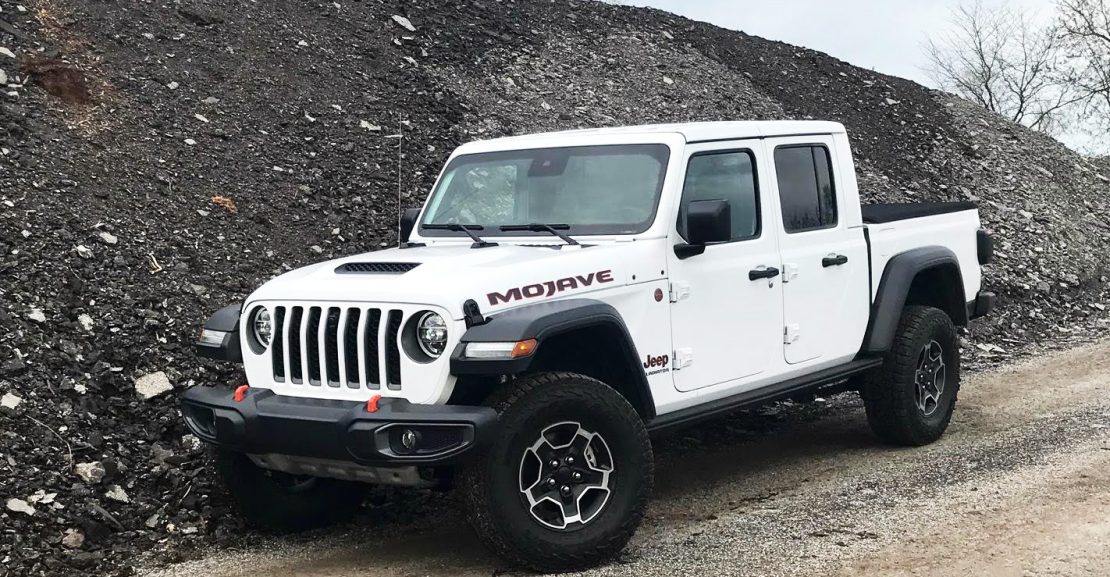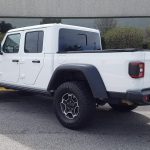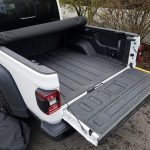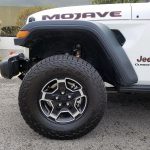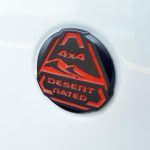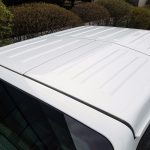
 2020 Jeep Gladiator Mojave 4X4
2020 Jeep Gladiator Mojave 4X4
Class: Compact Pickup
Miles driven: 172
Fuel used: 10.3 gallons
Real-world fuel economy: 16.7 mpg
Driving mix: 60% city, 40% highway
EPA-estimated fuel economy: 17/22/19 (city/highway/combined)
Fuel type: Regular gas
| CG Report Card | |
|---|---|
| Room and Comfort | B |
| Power and Performance | B- |
| Fit and Finish | B+ |
| Fuel Economy | C+ |
| Value | C+ |
| Report-card grades are derived from a consensus of test-driver evaluations. All grades are versus other vehicles in the same class. Value grade is for specific trim level evaluated, and may not reflect Consumer Guide's impressions of the entire model lineup. | |
| Big & Tall Comfort | |
| Big Guy | C+ |
| Tall Guy | C+ |
| Big & Tall comfort ratings are for front seats only. "Big" rating based on male tester weighing approximately 350 pounds, "Tall" rating based on 6'6"-tall male tester. | |
| Drivetrain | |
| Engine Specs | 285-hp 3.6-liter |
| Engine Type | V6 |
| Transmission | 8-speed automatic |
| Drive Wheels | 4WD |
Base price: $43,875 (not including $1495 destination charge)
Options on test vehicle: Upgraded interior with leather upholstery ($1495), Trailer Tow Package ($350), Cold Weather Group ($995), Premium LED Lighting Group ($1045), 8.4-inch Radio and Premium Audio Group ($1695), Active Safety Group ($895), Adaptive Cruise Control/Forward Collision Warning+ ($795), hardtop headliner ($555), Cargo Management Group with Trail Rail System ($895), roll-up tonneau cover ($595), automatic transmission ($2000), body-color 3-piece hardtop ($2295), heavy-duty Rock Slider with Step Assist by Mopar ($1050), wireless Bluetooth speaker ($295), 17-inch Low-Gloss Black polished wheels ($995), spray-in bedliner ($495), forward-facing TrailCam camera ($595)
Price as tested: $62,410
Quick Hits
The great: Specialized off-road capability; one-of-a-kind open-air-convertible capability
The good: Longer wheelbase means ride quality is better than a Jeep Wrangler; broad range of available features
The not so good: Steep pricing gets steeper as options are added; steering feel can demand frequent corrections in highway driving
More Gladiator price and availability information
John Biel
“Horses for courses” goes the saying about differing skill sets. “Gladiators for terrain” doesn’t have the same catchy ring to it, but it embodies the same idea now that Jeep has added a Mojave version of its new compact pickup.
The Gladiator was introduced for 2020 with a line-topping Rubicon model. A variation picked up from the Jeep Wrangler, from which the Gladiator is derived, the Rubicon is specially outfitted to serve the needs of people who get their kicks driving far off road over rocks and ruts—big ones. The Mojave caters to folks who prefer to go dune blasting over sandy deserts when they get away from it all. Indeed, while all other Gladiators are “Trail Rated“ in line with Jeep’s particular standards for off-road capability, the Mojave is the first Jeep of any kind to be “Desert Rated.”

Park the two most-specialized Gladiators side by side and at first glance they’d almost be hard to tell apart without their bold Shadow Gray hood decals spelling out which is which. Both roll on standard 33-inch Falken Wildpeak all-terrain tires and sprout twin tow hooks front and rear. A skid plate peeks out from beneath the front bumper of both models. They even claim the same base price: $45,370 with delivery.
First Spin: 2020 Jeep Wrangler EcoDiesel
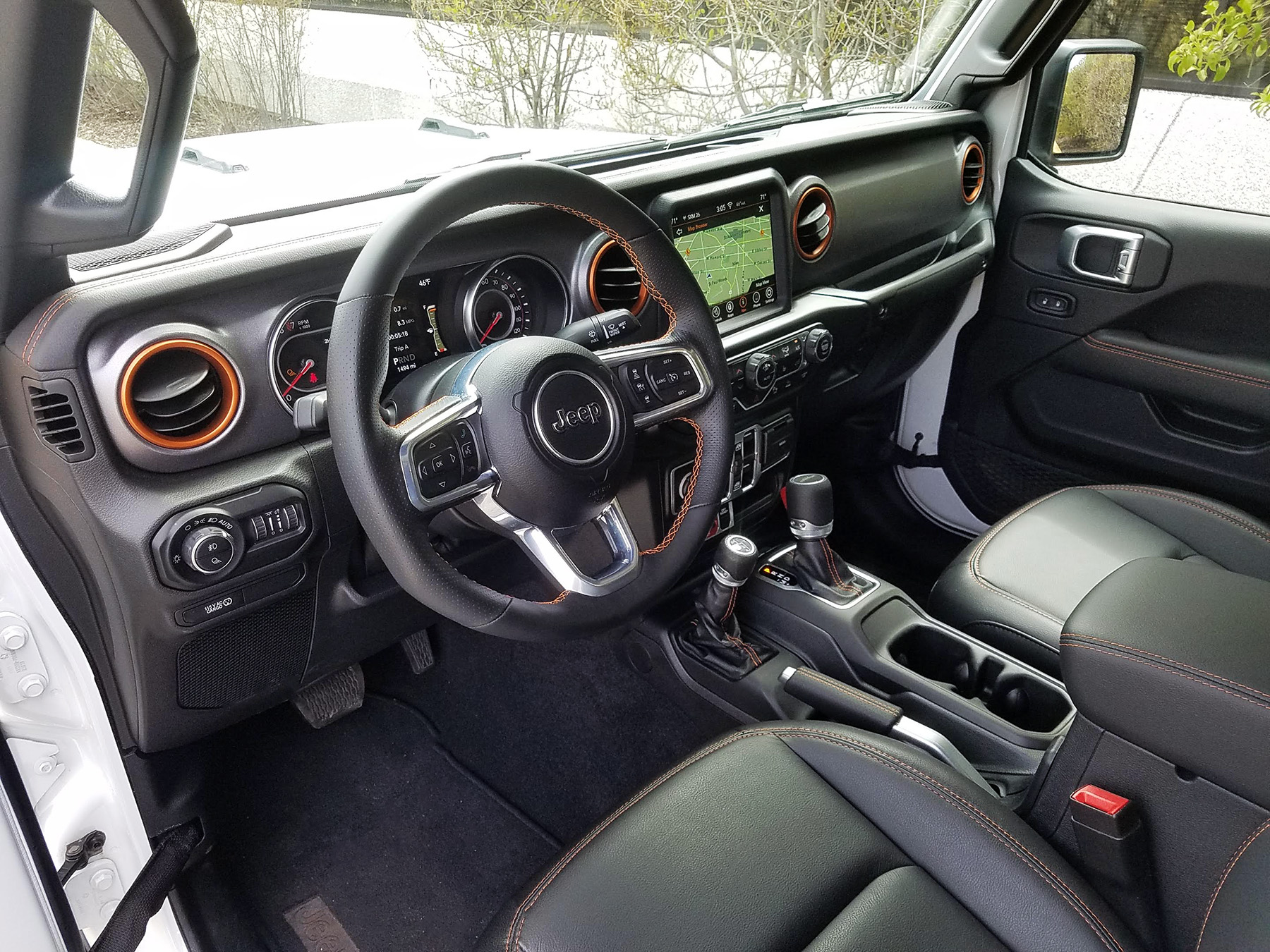
Look a little closer, though, and you’ll start to see differences. The Mojave has a hood with a central scoop in place of the Rubicon’s twin extractor vents. Designs and finishes of the 17 x 7.5-inch alloy wheels, both standard and optional, are different, and the Mojave has orange exterior accents—even the tow hooks—where the Rubicon uses red. The orange highlights carry over to the interior, where the Mojave’s front seats sport beefier upper bolsters.
Test Drive: 2020 Jeep Gladiator Overland

Digging a bit deeper reveals how the Mojave earned its merit badge. The frame and heavy-duty Dana axles are reinforced, and cast-iron steering knuckles are employed. A 1-inch front suspension lift makes room for heat-resistant FOX-brand 2.5-inch internal-bypass shocks and hydraulic front jounce bumpers. Steel slider rails run under the rocker panels for their protection from underbody obstacles.
To assist hard-charging runs through sand, Off-Road+ control located low in the dash allows drivers to adjust throttle, transmission shift points, and traction control when in 4-wheel-drive high range. The Mojave’s Off-Road+ is a little simpler than the one in the Rubicon because the desert runner only has an electronic locking rear axle instead of the rock climber’s front and rear locking axles and front antiroll-bar disconnect. With more of a need for speed on the dunes, the Mojave eschews the Rubicon’s two-speed transfer case, with its lower gearing, for the Command-Trac part-time unit found in all other Gladiators. Finally, the Mojave has what Jeep says is best-in-class ground clearance at 11.6 inches, which is 0.5 inch more than the Rubicon.
First Spin: 2020 Jeep Gladiator
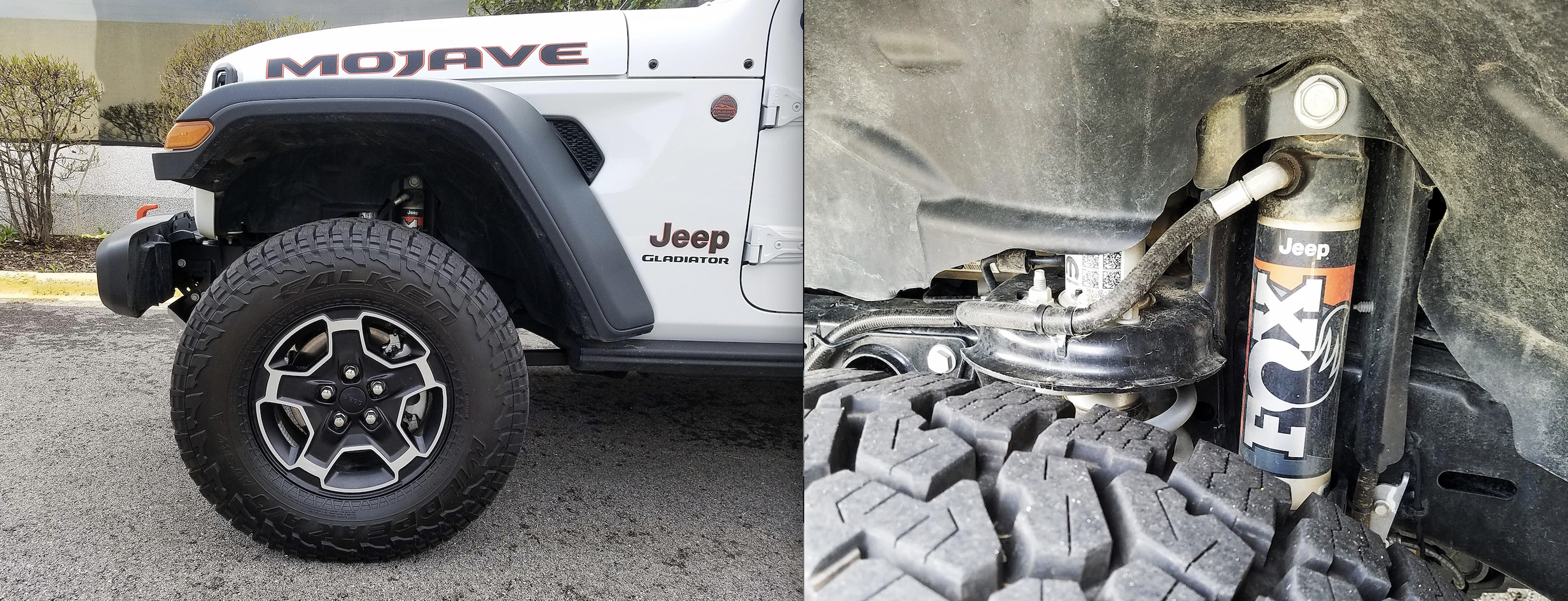
Desert terrain being in critically short supply near Consumer Guide’s Chicago-area offices, our time in the Mojave was spent on streets and expressways instead. While hardly comparable to a leap from the crest of a dune, the shocks from road cracks and highway expansion joints hit at speed were soaked up immediately. The deep-sidewall tires no doubt help with that somewhat, but their knobby tread sets up a steady vibration in expressway driving. Like Wranglers, Gladiators are prone to road wander, so constant small steering corrections will keep a driver busy.
The Mojave comes with the same 3.6-liter V6 standard in all Gladiators and the 6-speed manual transmission basic to most, though CG’s test truck was outfitted with the extra-cost 8-speed automatic. The 285-horsepower V6 is strong and responsive. Transmission operation is smooth and well-tailored to street and highway driving. Punch the throttle on the open road and the gearbox drops four ranges without a sigh to help accomplish a pass. Less subtle is the stop/start control included to conserve a little gas. EPA fuel-economy ratings for the Mojave with automatic at 17 mpg in the city, 22 mpg on the highway, and 19 combined. In our editors’ 172-mile test (which consisted of a slight majority of city driving), we averaged 16.7 mpg—a bit under the EPA city estimate.
2020 Chicago Auto Show: 2020 Jeep Wrangler JPP 20
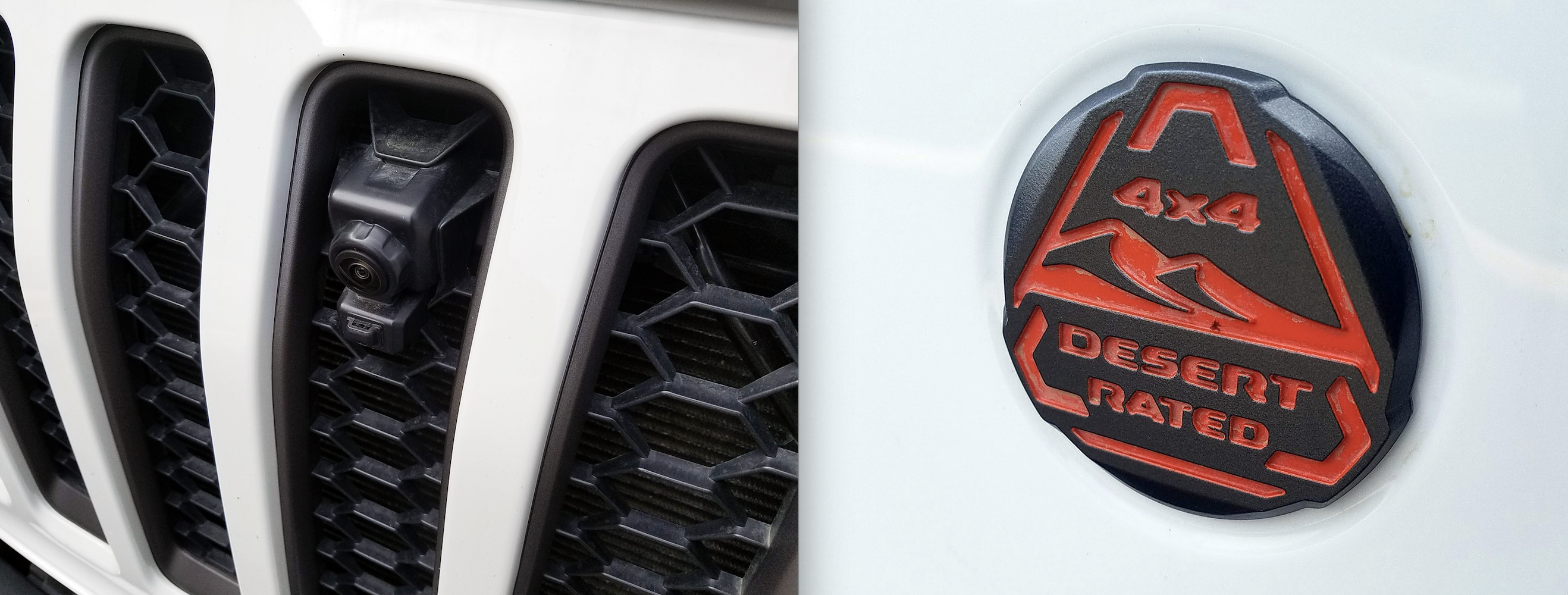
In addition to the automatic transmission, CG’s test vehicle was dressed to the nines with leather upholstery, heated front seats and steering wheel, a premium audio upgrade and navigation for the Uconnect 4C infotainment system, blind-spot and rear cross-traffic detection, adaptive cruise control, a body-color 3-piece hardtop, track-calculating forward “TrailCam,” and more. The final price inflated to $62,410. It is unfortunately easy to price this compact pickup up to the level of a pretty-well-equipped large truck.
The Mojave’s specific front seats are comfortable and grippy without being confining. Four average-sized adults will fit well in the big box of a cab that is at root the body of the four-door Wrangler Unlimited. Floor-height cup holders attached to the back of the console are all that stand in the way of fitting a third adult in the middle of the rear seat. Step-in will be a challenge for some passengers, even with the Mopar rock-slider steps added to the test vehicle.
There are some soft-touch surfaces on the dash and door panels/armrests. The dual-zone climate system uses convenient dials for temperature and fan-speed settings. The Uconnect 4C is easy to decipher and use. Personal-item storage options are varied, and even include a bin below the rear-seat cushions. All Gladiators have a 5-foot-long cargo bed.
The Gladiator Mojave serves as Jeep’s take on the desert-hopper trucks— Ford F-150 Raptor, Ram Rebel, et al.—that are now a part of the pickup scene. However, none of them could make an entrance like a Mojave flying in top and doors off, and windshield down.
Test Drive: 2020 Jeep Compass Trailhawk

Tom Appel
One reason I’ve always wanted a Jeep Wrangler is because I love the open-air cruising options available. The body-color Freedom Top removable roof panels on our test Gladiator Mojave provide a near-convertible experience along with a degree of security and foul-weather protection.
Removing the two panels is a snap, though anyone much less than 6 feet tall will need a step stool and/or a helper. My daughter and I were able to remove the panels in less than five minutes. Replacing the roof parts is somewhat more complicated, and takes about five minutes once you’ve learned the process. One note: My small but athletic daughter was unable to muscle the primary latch that secures each panel into place on her own. The problem is the long reach for shorter folks as well as the muscle required.
I’d argue that the effort required to remove the roof panels is completely justified by the top-down experience. Just be sure that if you pop the top, you can replace it in good time if the weather breaks bad.

Gladiator Mojave

